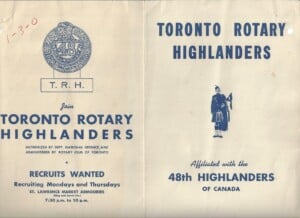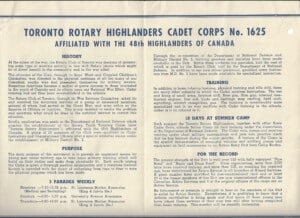– Documents:
Early in 1940, the Rotary Club of Toronto wanted to contribute to the war effort in a way that reflected Rotary ideals and would benefit the community directly. When they noticed the poor physical fitness of many of the young men volunteering for military service, they had the answer, a cadet corps directed at the youth of Toronto. Club members who, as 48th Highlanders, had served in the Great War and were either on the officer reserve list or inactive, volunteered. Twenty-five then qualified as instructors and commissioned officers, and that year the Rotary Youth Training Corps (Cadet Corps 1625), affiliated with the 48th Highlanders, was authorized.
Captain Charles E. Read, MC, was appointed Officer Commanding. “Beaver” Read was a well-known and respected figure within the 48th, who won his MC at Passchendaele and, at Waller Wood, was the last 15th Battalion officer wounded. Recruiting of youths aged 16 to 19 started immediately on Monday evenings at the St. Lawrence Market Armoury. Numbers grew quickly to 400 creating two companies, the York Company and the Malvern Company, who paraded initially on two weeknights at York Memorial and Malvern Collegiates respectively. New recruits received berets and sweatshirts bearing the Regimental crest with RYTC printed below. Battle dress uniforms followed, purchased half by the Rotary Club and half by the Department of National Defence. When on 27 February 1941, Military District No. 2 granted the use of the University Avenue Armouries on Sunday mornings, to replace one of the mid-week parades, it brought the parent regiment and the cadets even closer. The 48th provided rifles and the use of the rifle range plus lecture rooms for map reading and signalling. Captain Ronald McLeod, chaplain of the Cadet Corps, organized and held a drumhead service to begin each Sunday’s training.
Training emphasized physical fitness and basic military training including firing of small arms, bayonet and rifle drill, Bren gun, Sten gun, map reading and field craft. First aid and internal combustion engines rounded out the courses. Ten days in the summer at Bolton Camp was much anticipated by the cadets. Numbers grew to over 550 and a cadet pipe band, 20 strong, was formed, with equipment paid for by Rotary Club members and a donation of $1500 from Mr. Nielsen of Nielsen Chocolates to ensure that the band would parade in the Davidson tartan kilt. In 1943, they became the Toronto Rotary Highlanders, still affiliated with the 48th.
Recruiting Pamphlet
Front
Toronto Rotary Highlanders Affiliated with the 48th Highlanders of Canada
Inside, Toronto Rotary Highlanders Cadet Corps No, 1625 History, Purpose, 3 Parades Weekly, Training, 10 Days at summer camp, and For the Record.
Reverse
48th Highlanders T.R.H.
Join Toronto Rotary Highlanders
Authorized by Dept. National Defence and Administered by Rotary Club of Toronto
Recruits Wanted
Recruiting Mondays and Thursday
St. Lawrence Market Armouries (King and Jarvis Sts.) 7:30 p.m. to 10 p.m.


